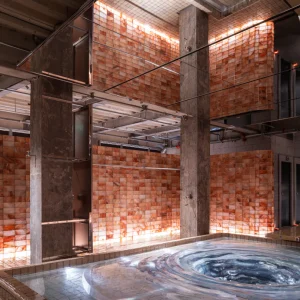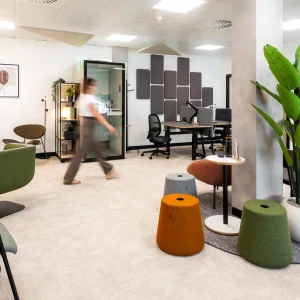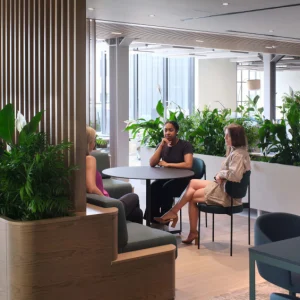Located in a hot, dry, desert type climate, on the outskirts of Jaipur, in the soulless Kukas industrial area about 20 kilometers from the city, the Pearl Academy ranks third in the top 10 fashion design institutes in India. The academy’s design needed to be a confluence of modern adaptations of traditional Indo-Islamic architectural elements, and passive cooling strategies prevalent in the hot-dry desert climate of Rajasthan.
The architectural design consists of a range of multifunctional spaces, seamlessly blending the interiors and exteriors. Many elements of this thermally adaptive environment borrow from the tradition of passive cooling techniques prevalent in the state of Rajasthan.
The entire building is raised above ground, creating sunken courtyards reminiscent of medieval stepped wells. This scooped out ‘underbelly’ with a large pool acts like a natural thermal sink and serves as a large recreation and exhibition zone. The pool, fed by the recycled water, helps in creating a microclimate, through evaporative cooling.
Passive environmental design helps achieve temperatures of about twenty degrees lower than the outside temperature, when it reaches 47 degrees Celsius during the height of summer. Passive climate control methods reduce dependence on expensive mechanical cooling and heating methods in a state with scarce energy resources.
The design reinterprets two traditional Rajasthani architectural motifs – the stone screen known as the ‘jaali’, and the open-to-sky courtyard. The jaali, traditionally used to screen private spaces and modulate light within buildings, is re-imagined as an exterior skin, and placed four feet away from the wall – acting as a thermal buffer. The density of the screen has been derived using computational shadow analysis based on orientation of the façades.
The courtyards take on undulating shapes within the regulated form of the cloister-like periphery and help control the temperature of internal spaces and open step-wells, while allowing sufficient day lighting inside studios and classrooms.
The academy is constructed using a mix of local stone, steel, glass and concrete, keeping in mind the climatic needs of the region while retaining the progressive design intent. With energy efficiency being a prime concern, the institute is 100% self-sufficient in terms of captive power and water supply, and promotes rainwater harvesting and wastewater re-cycling through the use of a sewage treatment plant.
Founded in 1996, Morphogenesis is a Delhi-based association of architects, designers, urbanists, and environmentalists. The firm derives its name from the Greek word ‘morphê’, literally meaning, beginning of the shape.





